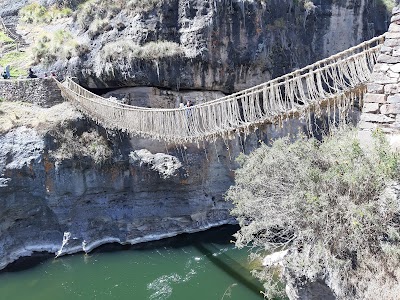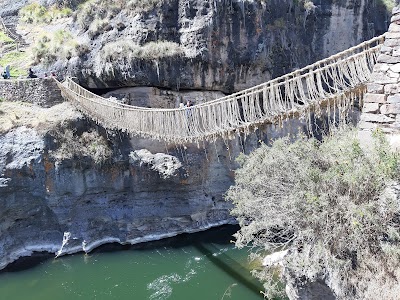Inca Bridge of Q'eswachaka (Q'eswachaka)
Overview
The Inca Bridge of Q'eswachaka, often dubbed the last surviving Inca bridge, stands as a remarkable testament to the engineering brilliance and cultural practices of the Inca civilization. Nestled in the Cusco region of Peru, about three hours by car from Cusco city, the Q'eswachaka Bridge gracefully spans the mighty Apurimac River. This handwoven grass bridge is not merely a historical artifact; it is a living embodiment of Inca heritage, rebuilt annually by local communities in a vibrant ceremony steeped in tradition and collective effort.
With a history that stretches over 500 years, the Q'eswachaka Bridge was originally constructed during the zenith of the Inca Empire as part of an extensive network of roads and bridges connecting its vast territories. This road system, known as the Qhapaq Ñan, facilitated the efficient movement of armies, goods, and information across the challenging Andean landscape. The bridges played a crucial role in this network, especially in areas where deep canyons and swift rivers made transportation particularly arduous.
What truly sets the Q'eswachaka Bridge apart is its entirely natural composition, crafted from ichu grass, which thrives in the high Andes. Each year in June, the bridge undergoes a complete dismantling and reconstruction using traditional Inca techniques passed down through generations. This annual rebuilding ceremony is a vibrant event that unites four local Quechua communities: Huinchiri, Chaupibanda, Choccayhua, and Ccollana Quehue. Community members, both men and women, partake in this ritual, which features traditional music, dance, and offerings to Pachamama, the Earth Mother, for protection and blessings.
The rebuilding process is a fascinating spectacle that unfolds over three days. On the first day, the grass is harvested and twisted into robust ropes. The second day focuses on weaving these ropes into large cables that form the bridge’s framework. Finally, on the third day, the main cables are stretched across the canyon, and the flooring and handrails are meticulously assembled. Observing this intricate process reveals the remarkable skill and teamwork required to uphold this sacred site.
Visiting the Q'eswachaka Bridge offers more than just a glimpse of an ancient engineering marvel. The bridge itself, swaying precariously over a steep canyon, provides an exhilarating experience for adventurous tourists eager to cross it and feel the thrill of walking in the footsteps of the Inca. The surrounding landscape of the Apurimac River Valley showcases stunning vistas, making it a photographer’s paradise. Additionally, visitors can engage with the local culture by interacting with the communities, learning about their traditions, and, if timed right, participating in the annual bridge-building festivities.
The Q'eswachaka Bridge is not only a historic structure but also a symbol of resilience and cultural continuity. Its annual reconstruction has earned recognition as an Intangible Cultural Heritage by UNESCO, underscoring its significance in global heritage. This acknowledgment plays a crucial role in preserving traditional practices and ensuring the bridge remains a lasting connection to the Inca past.
Moreover, the traditional knowledge and skills necessary for rebuilding the bridge are transmitted within the community, with elders passing down ancient techniques to younger generations. This intergenerational knowledge transfer is vital for maintaining the authenticity and continuity of the practice. The bridge also exemplifies sustainable engineering, utilizing local materials and undergoing an annual renewal process that reflects a profound respect for the environment—an ecological mindset integral to the Inca way of life.
For those planning a visit, it's essential to check the timing of your trip, as the bridge is closed for reconstruction every June. Witnessing this rebuilding process can be a highlight of your visit. Additionally, the journey to Q'eswachaka is a scenic adventure through the Andes, where you’ll pass charming villages, farmlands, and archaeological sites that offer further insights into the region's rich history and culture.
In conclusion, the Inca Bridge of Q'eswachaka represents a remarkable destination that seamlessly intertwines history, culture, and adventure. It stands as a living monument to the ingenuity and communal spirit of the Inca people, providing tourists with an unforgettable experience that transcends typical landmarks. Whether marveling at this engineering feat, participating in cultural rituals, or simply soaking in the breathtaking Andean scenery, a visit to Q'eswachaka is an enriching journey into the heart of Peru's ancient and vibrant heritage.






